The ingredient that changed my understanding of food
Many have not heard about it but it leaves a lasting impression
As the world has quickly fallen in love with miso, gochujang or fish sauce for their burst of umami and savoury flavours, there is a whole class of fermented oil seeds in West Africa that pack a unique and funky umami punch — the chief of them all — fermented locust beans.
Today’s “Lost” Crops of Africa series is all about fermented locust beans. Fermented locust beans are not lost, but their use and influence are slowly waining with the increase of overly processed seasoning cubes.
West African food is full of bold flavour, heat, and spices, reflecting our people. One subset of flavour additives that gives various West African foods their unique flavours are fermented products such as alkaline fermented oil seeds (sesame seeds/benne seeds, melon seeds, ugba, silk cotton seeds, hibiscus seeds, baobab seeds), most notably, locust beans.
Alkaline fermentation of oil seeds brings together tradition, history, culture, and spirituality to turn an inedible and unusable seed into a nutrition and flavour powerhouse.
These fermented locust beans serve as the traditional and primary umami powerhouse for many beloved West African dishes. Efo riro, egusi soup, okro soup, jute mallow soup, riz au sombala, maafe and many more are not the same without fermented locust beans. Fermented locust beans go by many names such as iru, ogiri, dawa dawa, nere, soumbala, netetou, kolgo and many more depending on who you ask.
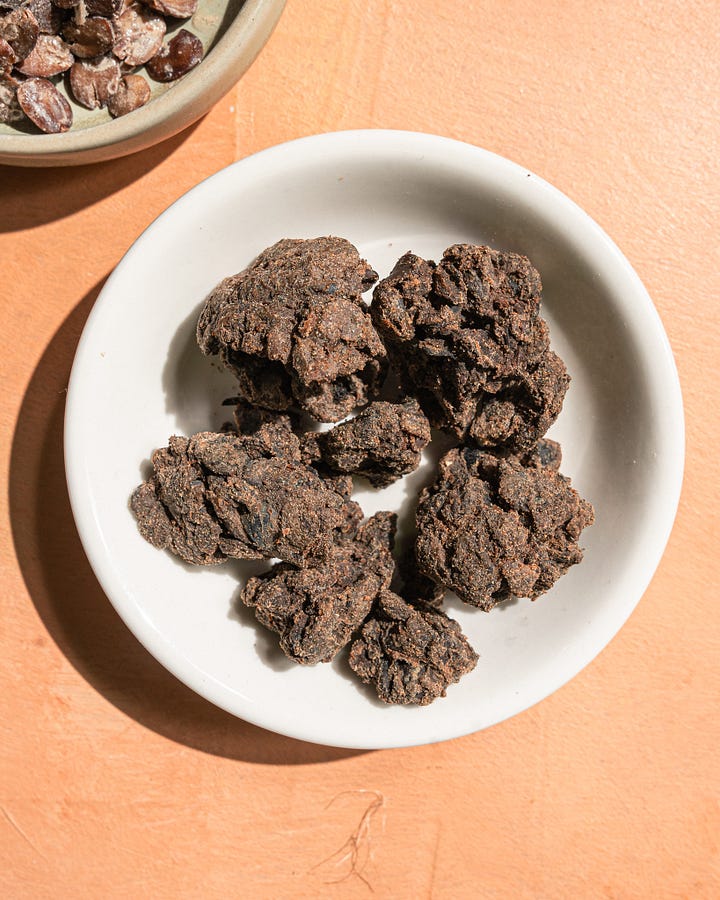
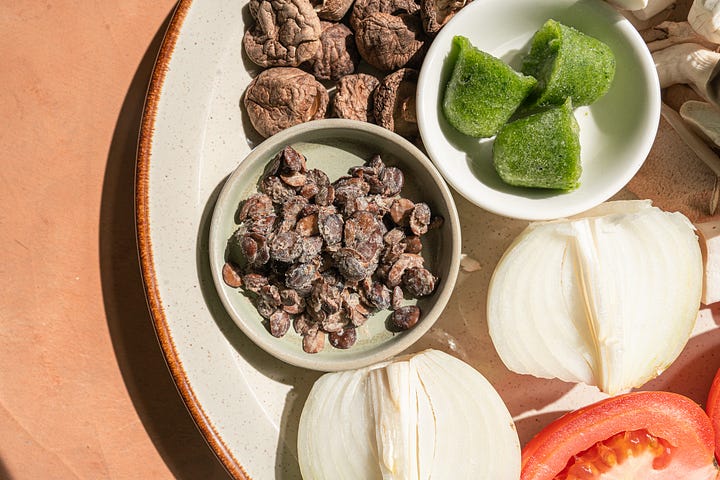
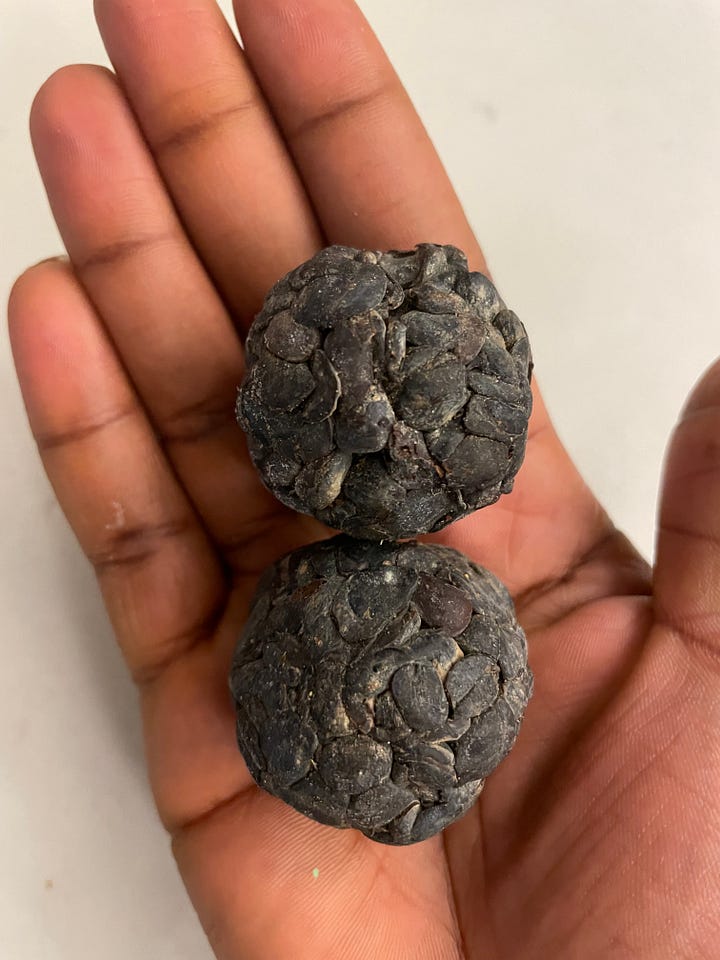
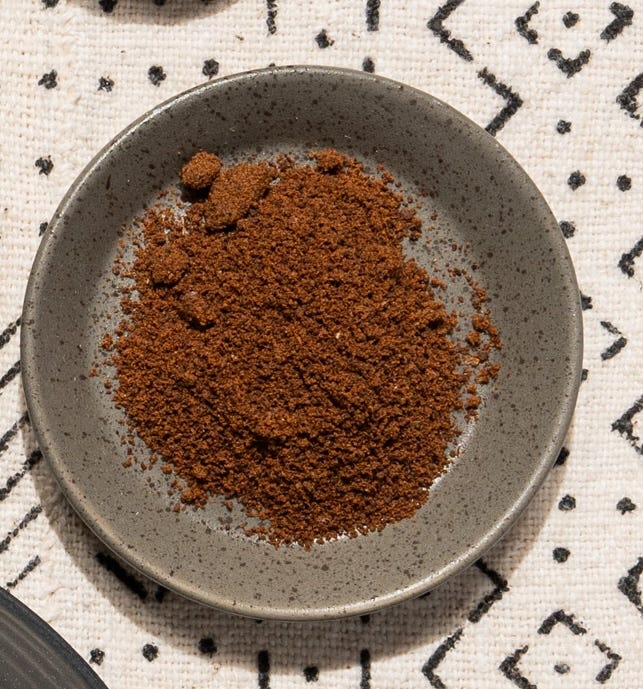
What do fermented locust beans taste like?
I understand comparisons are important in understanding flavour. Some might think fermented locust beans can be described similar to miso or doenjang, but they are definitely worlds apart. The fermentation process is actually closer to natto than it is to miso. I bring this up to highlight that some things need to be experienced on their own to fully understand the flavour and intent.
Like many West African ingredients, it is incredibly difficult to describe the flavour and taste. The recipe testers for my cookbook offered these descriptions
Dark Chocolate
Umami
Coffee
Gamey — like game meat
Funky
Smells like goat
Stinky like blue cheese
Where do Fermented Locust Beans Come From?
The African Locust tree - parkia biglobosa — grows in many parts of West Africa. These trees are interspersed amongst shea trees, with many living several decades or up to a century old. Like many West African trees, the bark, the root, and many parts of the tree have value in food and traditional medicine. In the hottest months of the year, the tree flowers, creating globular red flowers (as an aside, fruit trees in West Africa make the most beautiful and peculiar flowers) that turn into long pods filled with yellow fruit and inedible seeds. We get a true display of the ingenuity in West African food traditions when the inedible seeds are processed into magical flavour additives.

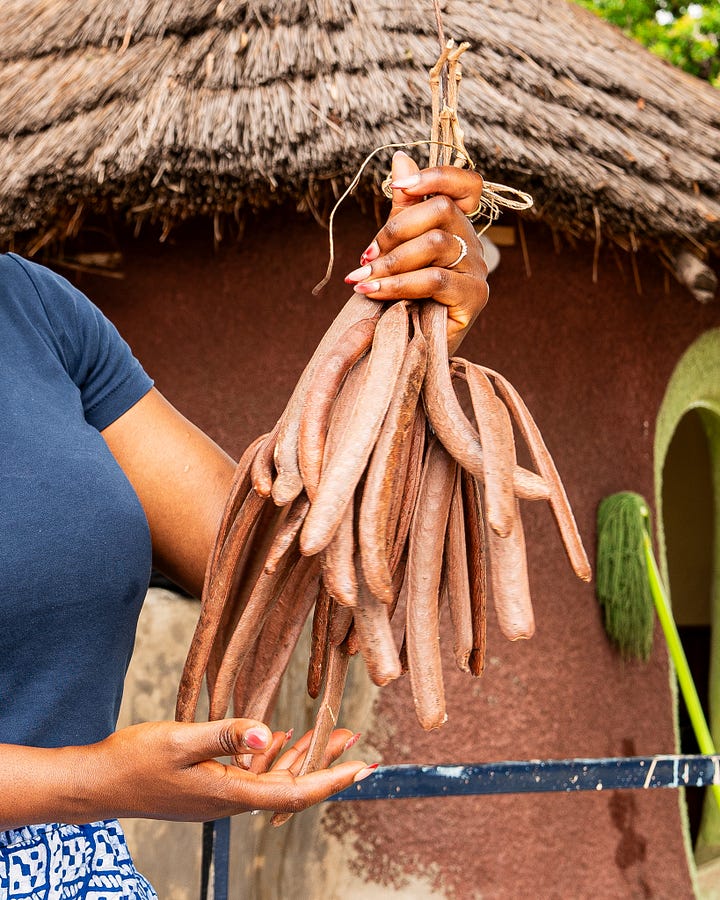
Before you get to the final product described above, there is a lot one has to do, which brings to question how people figured this out. That is an answer I do not have, but like many Ghanaian herbalists have told me, including stories from my great grandmother, a lot of how we have come to understand our natural world has been revealed through dreams from ancestors. A common answer that brings into focus the interconnection between food and spirituality. Other explanations include direction by an animal connected to an ancestor or a god in the spiritual realm or a not-so-happen-chance encounter from a spiritual entity. Rarely are things ascribed to chance alone. I am not sure which path brought us fermented locust beans, but every unique and important part of our food traditions is always connected to spiritual practices.
How fermented locust beans are made
When one cracks open the dried locust fruit pods, one finds a long strip of yellow fruit with a dry texture (almost like velvet tamarind) and a subtle sweet, tart flavour. The fruit is great as a snack; I like to blend them into smoothies. Hidden within these fruits are hard, protein-filled, inedible seeds, which are subsequently subjected to a 3 days process of boiling, pounding, fermenting, and drying to get the final product. Across West Africa, there are slight variations in the process, but I will share what I learned in Tongo (Upper East Ghana). As an aside, the dried pods can be used as a dye/natural paint for homes.
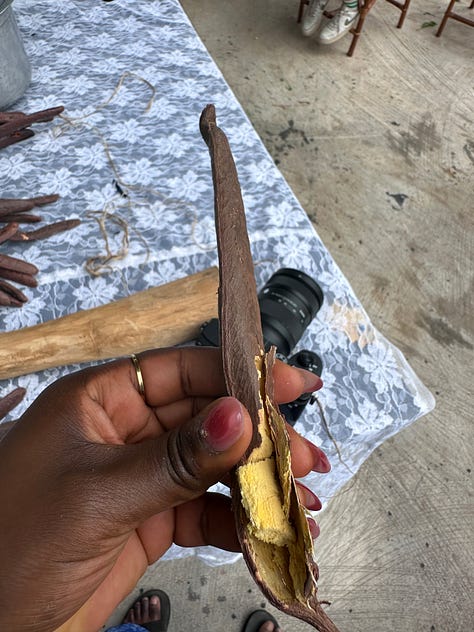
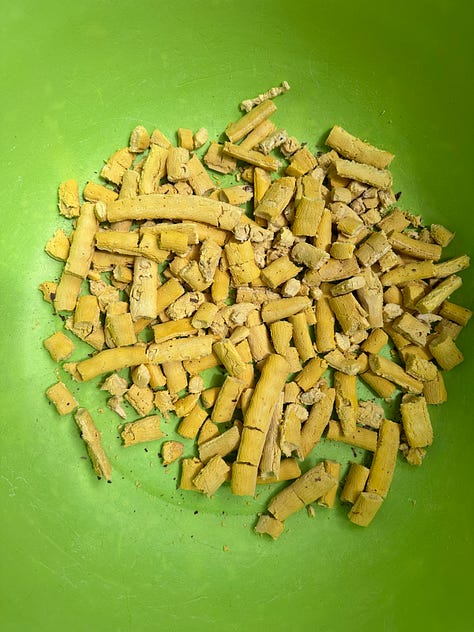


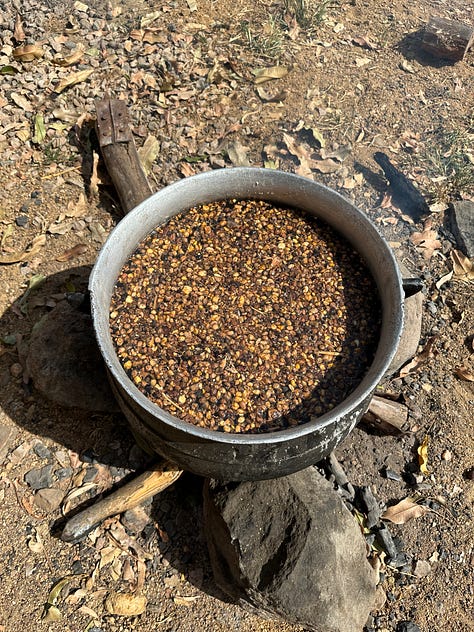

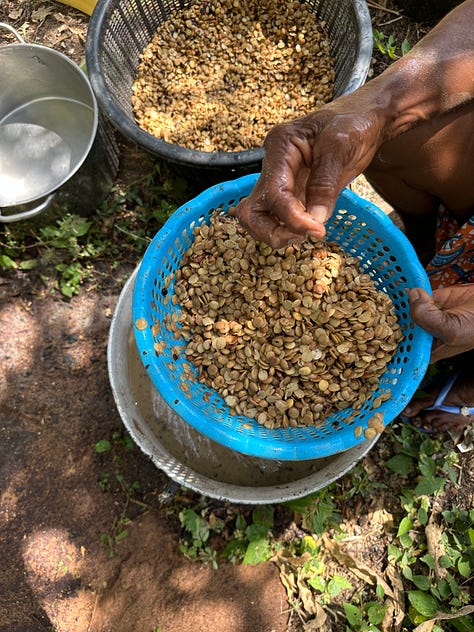

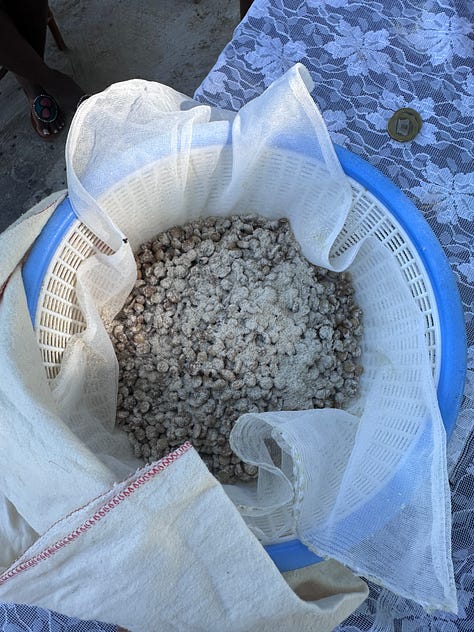

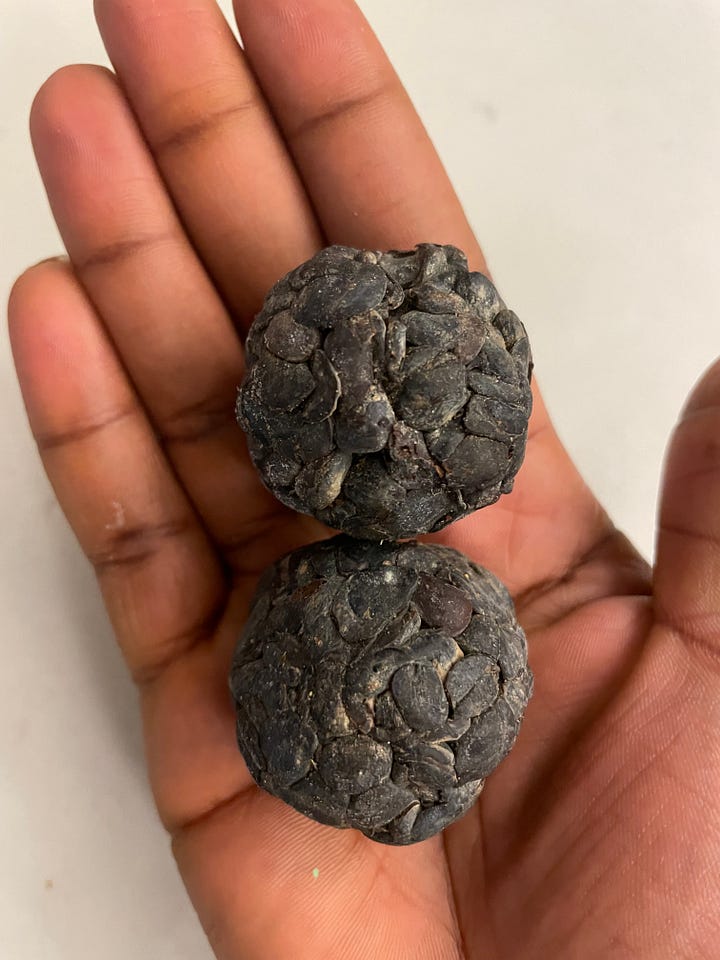
The fruits are removed from the dried pulps.
The fruits are pounded to separate the seed from the fruit.
A special clay pot, made just for sieving out the locust beans, is used to separate the dried seeds from the fruit.
The seeds are boiled for hours.
The boiled seeds are pounded (with sand) to remove the outer shell.
The seeds are thoroughly washed and boiled until tender — these are great snacks.
The beans are layered in a colander with ash or millet and fermented for 48 hours. This step is where the magic really happens.
The fermented seeds are dried — some clump it into a ball as they dry.
Why alkaline fermentation is unique
Many of the fermented foods we know and love are usually acidic in nature. Yeast and bacteria digest the sugars in foods and turn them into an alcohol or an acid. This reduces the pH and turns the food sour. Alkaline fermentation is a bit of a different process. Compared to acidic fermented foods that are carbohydrates heavy, alkaline fermented foods have noticeable amounts of protein content. Locust beans are said to be about 35-40% protein. Fermenting these seeds in an alkaline environment (i.e eith ash) is a recipe for a unique type of fermentation. The bacteria involved in alkaline fermentation are a different subset of bacillus bacteria. These bacteria break down the protein in these oil seeds into their amino acid building blocks with ammonia as a by-product as well as other odour compounds that give the fermented locust beans a strong smell. This fermentation reaction increases the pH of the locust beans. Glutamate is also present amongst these amino acids, which contributes to the umami flavour, making fermented locust beans a natural MSG alternative. In addition, complex carbohydrates in these seeds, usually indigestible, are broken down into simpler sugars that are easier to digest. (Reference) Lastly, fermentation and drying extend the shelf life, making it a useful and long-lasting ingredient in the kitchen. In all, you go from an unpalatable, undigestible product to a completely different final product.
Many West African fermented are spontaneous ferments, rarely are fungus or yeast used to inoculate the food (with exception of pito which sometimes uses yeast).
Learning about the science behind this has been mind-blowing for me. Especially in a world where African food is reduced to very little, knowing we have so much to offer is truly eye opening.
How do I use fermented locust beans in my kitchen?
Fermented locust beans are used as flavour additives, packed with glutamate, umami flavour, and smells that make traditional West African dishes unique. Fermented locust beans are not as commonly used in southern Ghanaian cooking as people prefer fermented salted fish; however, since I do not eat meat, I use it in place of fermented salted fish and it is perfect.
It is part of my all-purpose umami seasoning blend — it goes in my soups, in my stews and many more. I use it to cook mushrooms, to cook tofu, to make my chilli oils and anything that needs a savoury flavour. I have a spice blend on my website you can check out.
My ambitious use is in my Christmas chocolate chip cookies; you can learn all about it in this post.
You can always experiment with its use in other dishes of your choosing.
A recipe that fully displays fermented locust beans
Mouyi Kolgo (Riz au Soumbala)
Mouyi translates to rice and kolgo/kolko translates to fermented locust beans in Mooré (a Burkina Faso language), with similar variants found in gurune languages. But in french, the recipe is riz au soumbala. This one-pot rice dish is typically made with Indigenous West African rice, meat broth and soumbala/fermented locust beans. To maintain this recipe as fully plant-based, I will be using a diversity of flavourful mushrooms to add texture and flavour.
Broth
1 pack of oyster mushrooms (~2 cups)
1 handful of dried mushrooms
1 vegetable bouillon cube (I use 1 tablespoon of better than bouillon vegetable paste)
3 tablespoons of nokoss***
2 tablespoons dried soumbala/fermented locust beans
Rice
2-3 tablespoons of vegetable oil
1 onion finely diced
1 tomato finely chopped
2 cups of white rice — medium or long grain
Direction
Rinse the dry soumbala to remove any dirt or debris, then soak in 3 cups of hot water for 15 minutes. While it is soaking, prep the rest of your ingredients
Remove the soumbala from the soaking liquid and set aside. Add the rest of the broth ingredients to the soumbala soaking liquid and boil for 10 minutes.
As the broth is boiling, sauté the diced onion in the oil at medium heat until soft.
Add the tomatoes and cook down for another 10 minutes until soft.
Add the broth to the tomato onion base and boil for 5-10 minutes to allow the flavour to meld together.
Add the rice and cover the pot with a paper towel to seal the moisture.
Cook at medium low heat for 25-30 minutes until the rice is tender.
Serve.
***Notes
Nokoss Alternative: 3 cloves of garlic, 1 thumb size of ginger, 2 spring onions blended into a paste
Where can I find fermented locust beans?
Local African stores sell them; I recommend purchasing the dried powder version as that offers you the most flexibility.
For US and Canada shoppers, online spice companies like Ekaterra Co (black and Nigerian owned) and Burlap and Barrel stock them.
You can also check etsy and facebook market place for online vendors.
Unfortunately, nothing works as a perfect substitute.




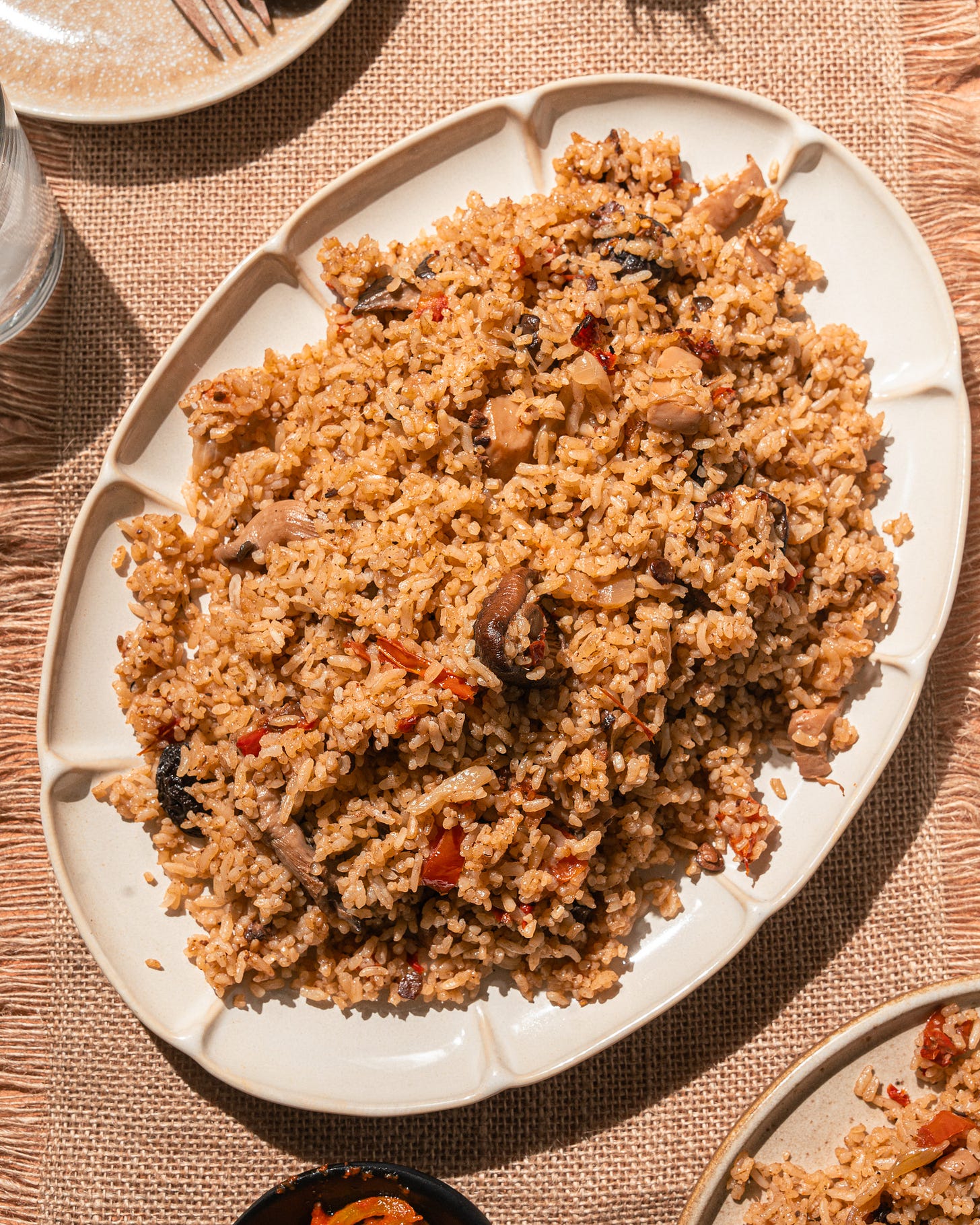
As someone from northern Nigeria, this article truly resonated with me! Growing up, we would climb the African locust bean tree (Parkia biglobosa), which we called Doruwa, and enjoy its sweet yellow pulp straight from the pod. It was such a fun childhood memory! But I was today years old when I learned that Doruwa is actually the source of Dadawa (our northern name for fermented locust beans), an essential ingredient in dishes like Miyan Kuka and Miyan Taushe. I always thought it was just a tree that produced fruit like apples, I never realized its seeds were transformed into such an important umami-rich seasoning. This article beautifully highlights the deep-rooted traditions, culture, and ingenuity behind our food. I learned something new today, and I’m super excited! Thank you for this!
Amazing! We have various tree legumes that grow where I live here in upstate New York, like honey locust and Kentucky coffee tree. The seeds are mostly considered inedible, but reading accounts like this has me convinced that there simply isn’t a food culture that has learned how to properly process them into edible forms. I may have to experiment with alkaline fermentation :)